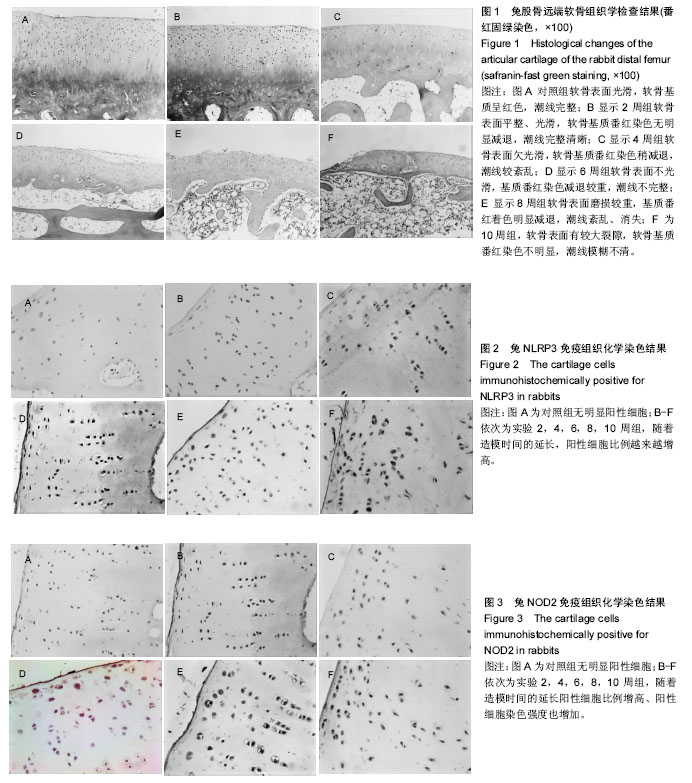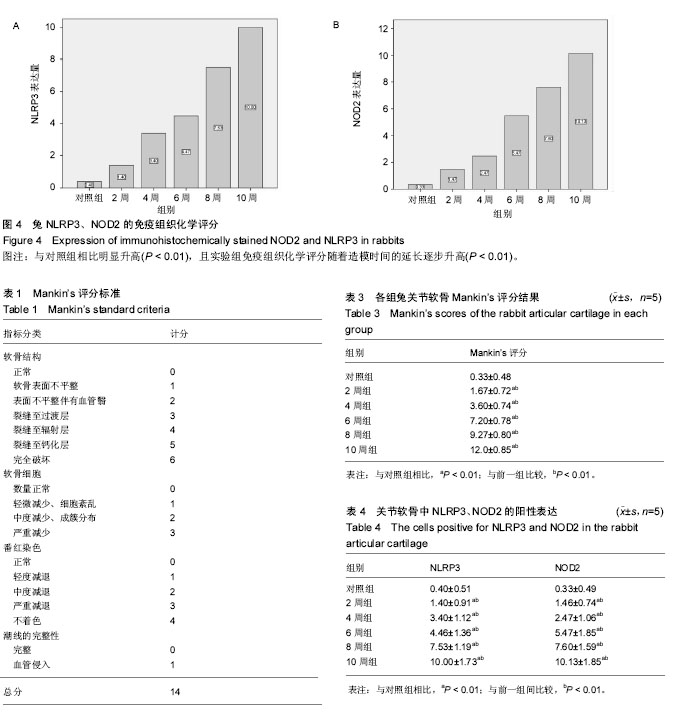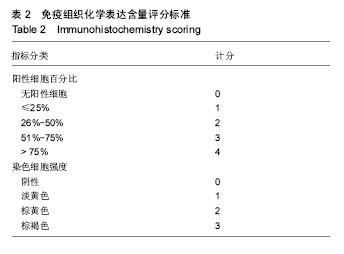中国组织工程研究 ›› 2018, Vol. 22 ›› Issue (8): 1211-1216.doi: 10.3969/j.issn.2095-4344.0139
• 组织构建实验造模 experimental modeling in tissue construction • 上一篇 下一篇
NOD2、NLRP3在石膏关节制动法建立兔膝骨性关节炎模型关节软骨中的表达
孙银铁,郭开今,蔡红星
- 徐州医科大学,江苏省徐州市 221004
Expression of NOD2 and NLRP3 in the articular cartilage of a rabbit model of osteoarthritis established by arthrorisis using plaster cast
Sun Yin-tie, Guo Kai-jin, Cai Hong-xing
- Xuzhou Medical University, Xuzhou 221004, Jiangsu Province, China
摘要:
文章快速阅读:
.jpg) 文题释义:
高分子石膏:统称“高分子绷带或高分子夹板”,是传统石膏的升级换代产品,其主要由进口聚氨酯、聚酯和高分子纤维组成,其使用卫生、简单、轻便、硬化快、不怕水、无毒、无副作用,是骨科外固定理想的固定材料。
NOD样受体:又被称作炎症小体,是一种模式识别受体,主要存在于细胞质中,作为模式识别受体在自身免疫反应起始阶段中起重要作用,当受到细菌外毒素、破裂的溶酶体等等刺激之后活化,活化之后的炎症小体可以激活半光天冬氨酸蛋白酶1(caspase-1)蛋白从而促进细胞的死亡以及炎症反应。
文题释义:
高分子石膏:统称“高分子绷带或高分子夹板”,是传统石膏的升级换代产品,其主要由进口聚氨酯、聚酯和高分子纤维组成,其使用卫生、简单、轻便、硬化快、不怕水、无毒、无副作用,是骨科外固定理想的固定材料。
NOD样受体:又被称作炎症小体,是一种模式识别受体,主要存在于细胞质中,作为模式识别受体在自身免疫反应起始阶段中起重要作用,当受到细菌外毒素、破裂的溶酶体等等刺激之后活化,活化之后的炎症小体可以激活半光天冬氨酸蛋白酶1(caspase-1)蛋白从而促进细胞的死亡以及炎症反应。
.jpg) 文题释义:
高分子石膏:统称“高分子绷带或高分子夹板”,是传统石膏的升级换代产品,其主要由进口聚氨酯、聚酯和高分子纤维组成,其使用卫生、简单、轻便、硬化快、不怕水、无毒、无副作用,是骨科外固定理想的固定材料。
NOD样受体:又被称作炎症小体,是一种模式识别受体,主要存在于细胞质中,作为模式识别受体在自身免疫反应起始阶段中起重要作用,当受到细菌外毒素、破裂的溶酶体等等刺激之后活化,活化之后的炎症小体可以激活半光天冬氨酸蛋白酶1(caspase-1)蛋白从而促进细胞的死亡以及炎症反应。
文题释义:
高分子石膏:统称“高分子绷带或高分子夹板”,是传统石膏的升级换代产品,其主要由进口聚氨酯、聚酯和高分子纤维组成,其使用卫生、简单、轻便、硬化快、不怕水、无毒、无副作用,是骨科外固定理想的固定材料。
NOD样受体:又被称作炎症小体,是一种模式识别受体,主要存在于细胞质中,作为模式识别受体在自身免疫反应起始阶段中起重要作用,当受到细菌外毒素、破裂的溶酶体等等刺激之后活化,活化之后的炎症小体可以激活半光天冬氨酸蛋白酶1(caspase-1)蛋白从而促进细胞的死亡以及炎症反应。摘要
背景:NOD样受体在抵抗外部病原微生物、自身的非细菌性炎症反应以及自身免疫反应过程的起始阶段中起着重要的作用,而NLRP3和NOD2是NOD样受体家族中具有代表性的两种重要蛋白。
目的:观察兔膝骨性关节炎模型中软骨细胞NOD2、NLRP3表达。
方法:30只新西兰大白兔随机分为6组:实验组分别设置2,4,6,8,10周组,采用石膏关节制动法建立兔左侧膝关节膝骨性关节炎模型,分别于术后2,4,6,8,10周处死对应实验组兔子;对照组不做任何处理,于第10周处死兔子5只。留取所有兔子的左股骨远端关节软骨标本,进行番红固绿染色,用Mankin’s法进行关节病理评分,免疫组织化学检测关节软骨中NOD2、NLRP3的表达水平。
结果与结论:①Mankin’s评分结果显示:实验组病理评分显著高于对照组(P < 0.01),而且随着造模时间的推移各组间的Mankin’s评分增加,均有显著性差异(P < 0.01);②免疫组织化学结果表明:NLRP3、NOD2在软骨细胞中的表达含量随着造模时间的推移也显著增高(P < 0.01);③结果说明,NOD2、NLRP3在软骨细胞中的表达与膝骨性关节炎的病理变化程度呈正相关性,可能是通过促进细胞凋亡进而加速膝骨性关节炎的发生发展。
中国组织工程研究杂志出版内容重点:组织构建;骨细胞;软骨细胞;细胞培养;成纤维细胞;血管内皮细胞;骨质疏松;组织工程
ORCID: 0000-0003-0473-1604(孙银铁)
中图分类号:



.jpg) 文题释义:
高分子石膏:统称“高分子绷带或高分子夹板”,是传统石膏的升级换代产品,其主要由进口聚氨酯、聚酯和高分子纤维组成,其使用卫生、简单、轻便、硬化快、不怕水、无毒、无副作用,是骨科外固定理想的固定材料。
NOD样受体:又被称作炎症小体,是一种模式识别受体,主要存在于细胞质中,作为模式识别受体在自身免疫反应起始阶段中起重要作用,当受到细菌外毒素、破裂的溶酶体等等刺激之后活化,活化之后的炎症小体可以激活半光天冬氨酸蛋白酶1(caspase-1)蛋白从而促进细胞的死亡以及炎症反应。
文题释义:
高分子石膏:统称“高分子绷带或高分子夹板”,是传统石膏的升级换代产品,其主要由进口聚氨酯、聚酯和高分子纤维组成,其使用卫生、简单、轻便、硬化快、不怕水、无毒、无副作用,是骨科外固定理想的固定材料。
NOD样受体:又被称作炎症小体,是一种模式识别受体,主要存在于细胞质中,作为模式识别受体在自身免疫反应起始阶段中起重要作用,当受到细菌外毒素、破裂的溶酶体等等刺激之后活化,活化之后的炎症小体可以激活半光天冬氨酸蛋白酶1(caspase-1)蛋白从而促进细胞的死亡以及炎症反应。